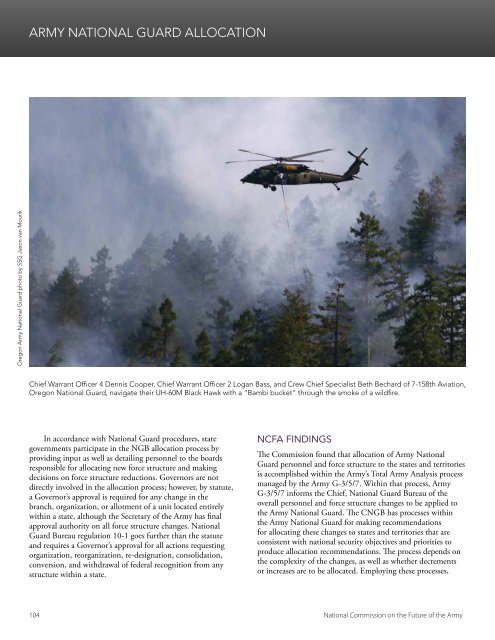THE FUTURE OF THE ARMY
Futurearmy
Futurearmy
Create successful ePaper yourself
Turn your PDF publications into a flip-book with our unique Google optimized e-Paper software.
<strong>ARMY</strong> NATIONAL GUARD ALLOCATION<br />
Oregon Army National Guard photo by SSG Jason van Mourik<br />
Chief Warrant Officer 4 Dennis Cooper, Chief Warrant Officer 2 Logan Bass, and Crew Chief Specialist Beth Bechard of 7-158th Aviation,<br />
Oregon National Guard, navigate their UH-60M Black Hawk with a “Bambi bucket” through the smoke of a wildfire.<br />
In accordance with National Guard procedures, state<br />
governments participate in the NGB allocation process by<br />
providing input as well as detailing personnel to the boards<br />
responsible for allocating new force structure and making<br />
decisions on force structure reductions. Governors are not<br />
directly involved in the allocation process; however, by statute,<br />
a Governor’s approval is required for any change in the<br />
branch, organization, or allotment of a unit located entirely<br />
within a state, although the Secretary of the Army has final<br />
approval authority on all force structure changes. National<br />
Guard Bureau regulation 10-1 goes further than the statute<br />
and requires a Governor’s approval for all actions requesting<br />
organization, reorganization, re-designation, consolidation,<br />
conversion, and withdrawal of federal recognition from any<br />
structure within a state.<br />
NCFA FINDINGS<br />
The Commission found that allocation of Army National<br />
Guard personnel and force structure to the states and territories<br />
is accomplished within the Army’s Total Army Analysis process<br />
managed by the Army G-3/5/7. Within that process, Army<br />
G-3/5/7 informs the Chief, National Guard Bureau of the<br />
overall personnel and force structure changes to be applied to<br />
the Army National Guard. The CNGB has processes within<br />
the Army National Guard for making recommendations<br />
for allocating these changes to states and territories that are<br />
consistent with national security objectives and priorities to<br />
produce allocation recommendations. The process depends on<br />
the complexity of the changes, as well as whether decrements<br />
or increases are to be allocated. Employing these processes,<br />
104 National Commission on the Future of the Army


